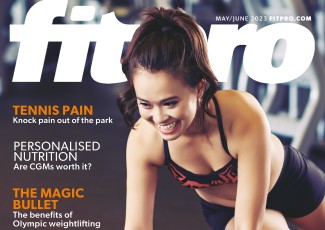Magazine References
May – Jun 2023

Pg 6-7 Depression, anxiety and cancer
References
- Smith H R (2015), Depression in cancer patients: Pathogenesis, implications and treatment, Oncology Letters, 9: 1,509-14.
- Niedzwiezdz C et al (2019), Depression and anxiety among people, living with and beyond cancer: A growing clinical and research priority, BMC Cancer, 19: 943.
- Brown J C et al (2012), The efficacy of exercise in reducing depressive symptoms among cancer survivors: A meta-analysis, PLos One, 7(1): e30955.
- Marconcin P et al (2022), Impact of exercise training on depressive symptoms in cancer patients: A critical analysis, Biology, 11: 614.
- Currier M, Nemeroff C (2014), Depression as a risk factor for cancer: From pathophysiological advances to treatment implications, Annu Rev. Med., 65: 203-211.
- Newton R (2022), Prostate cancer treatment with exercise medicine, Trends in Urology and Mens Health.
- Cormie et al (2017), The impact of exercise on cancer mortality, recurrence and treatment related adverse effects, Epid Rev., 39: 71-93.
Pg 14-17 Personalised nutrition: A deep dive into continuous glucose monitors
References
- Zeevi D et al (2015), Personalised nutrition by prediction of glycaemic responses, Cell, 19, 163(5): 1,079-94.
- Blaak E et al (2012), Impact of postprandial glycaemia on health and prevention of disease, Obes Rev., 12(10): 923-84.
- Shah V et al (2019), Continuous glucose monitoring profiles in healthy nondiabetic participants: a multicentre prospective study, J Clin Endocrinol Metab., 1: 104(10): 4,356-64.
- Wasserman D (2009), Four grams of glucose, Am J Physiol Endocrinol Metab., 296(1).
- Hanseen N et al (2020), Postprandial glucose spiked and important contributor to cardiovascular disease in diabetes, Front Cardiovasc Med., 7: 570553.
- Berry S et al (2020), Human postprandial responses to food and potential for precision nutrition, Nat Med., 26(6): 964-73.
- Merino et al (2022), Validity of continuous glucose monitoring for categorising glycaemic responses to diet: Implications for use in personalised nutrition, Am J Clin Nut., 7, 115(6): 1,569-76.
- Park et al (2020), Glucose metabolism responses to perceived sugar intake more than actual sugar intake, Sci Rep., 10(1): 1,5633.
- Baron K et al. Orthosomnia: Are some patients taking the quantified self too far, J Clin Sleep Med., 13(2): 351-4.
- Falchi M et al (2008), Quantitative linkage analysis for pancreatic B-cell function and insulin resistance in a large twin cohort, Diabetes, 57(4): 1,130.
- Berry et al (2020), The effect of postprandial glucose dips on hunger and energy intake in 1102 subjects in US and UK: the PREDICT 1 study, Current Developments in Nutrition, 4(2), 1,611.
- Jo A et al (2019), Is there a benefit to patients using wearable devices such as fitbit or health apps on mobiles? A systematic review, Am J Med. 132(12): 1,394-400.
- Nuss K et al (2021), Effects of Motivational interviewing and wearable fitness trackers on motivation and physical activity: a systematic review, Am J Health Promot., 35(2): 226-35.
- Shin G et al (2019), Beyond novelty effect: a mixed methods exploration into the motivation for long-term activity tracker use, JAMIA Open, 2(1): 62-72.
Pg 28-31 Olympic Weightlifting: The magic bullet?
References
- Stone MH, Pierce KC, Sands WA, Stone ME (2006), Weightlifting: A brief overview, Strength & Conditioning Journal, 28(1): 50-66.
- Suchomel TJ, Comfort P, Stone MH (2015), Weightlifting pulling derivatives: Rationale for implementation and application, Sports Medicine, 45: 823-39.
- Suchomel TJ, Nimphius S, Bellon CR, Stone MH (2018), The importance of muscular strength: training considerations, Sports Medicine, 48: 765-85.
- Pierce KC, Hornsby WG, Stone MH (2022), Weightlifting for children and adolescents: a narrative review, Sports Health, 14(1): 45-56.
- Comfort P, Haff GG, Suchomel TJ, Soriano MA, Pierce KC, Hornsby WG, Haff EE, Sommerfield LM, Chavda S, Morris SJ, Fry AC (2022), National Strength and Conditioning Association position statement on weightlifting for sports performance, The Journal of Strength & Conditioning Research, 10-519.
- Morris SJ, Oliver JL, Pedley JS, Haff GG, Lloyd RS (2022), Comparison of weightlifting, traditional resistance training and plyometrics on strength, power and speed: a systematic review with meta-analysis, Sports Medicine, 52(7): 1,533-54.
- Chaouachi A, Hammami R, Kaabi S, Chamari K, Drinkwater EJ, Behm DG (2014), Olympic weightlifting and plyometric training with children provides similar or greater performance improvements than traditional resistance training, The Journal of Strength & Conditioning Research, 28(6): 1,483-96.
- Berton R, Silva DD, Santos ML, Silva CM, Tricoli V (2022), Weightlifting derivatives vs. plyometric exercises: Effects on unloaded and loaded vertical jumps and sprint performance, Plos one, 17(9): e0274962.
- Tricoli V, Lamas L, Carnevale R, Ugrinowitsch C (2005), Short-term effects on lower-body functional power development: Weightlifting vs. vertical jump training programs, The Journal of Strength & Conditioning Research, 19(2): 433-7.
- Otto III WH, Coburn JW, Brown LE, Spiering BA (2012), Effects of weightlifting vs. kettlebell training on vertical jump, strength, and body composition, The Journal of Strength & Conditioning Research, 26(5): 1,199-202.
- Suchomel TJ, Nimphius S & Stone MH (2016), The importance of muscular strength in athletic performance, Sports Medicine, 46: 1,419-49.
- Sarvestan J, Svoboda Z, de Oliveira Claudino JG (2020), Force-time curve variables of countermovement jump as predictors of volleyball spike jump height, German Journal of Exercise and Sport Research, 50(4): 470-6.
- Blazevich AJ, Wilson CJ, Alcaraz PE, Rubio-Arias JA (2020), Effects of resistance training movement pattern and velocity on isometric muscular rate of force development: a systematic review with meta-analysis and meta-regression, Sports Medicine, 50: 943-63.
- Dann RA, Kelly V (2021), Evidence-based strength and conditioning plan for freestyle snowboarding athletes, Strength and Conditioning Journal, 43(5): 1.
- Turpeinen JT, Freitas TT, Rubio‐Arias JÁ, Jordan MJ, Aagaard P (2020), Contractile rate of force development after anterior cruciate ligament reconstruction—a comprehensive review and meta‐analysis, Scandinavian Journal of Medicine & Science in Sports, 30(9): 1,572-85.
- Szafraniec R, Bartkowski J, Kawczyński A (2020), Effects of short-term core stability training on dynamic balance and trunk muscle endurance in novice olympic weightlifters, Journal of Human Kinetics, 74(1): 43-50.
- Hermassi S, Chelly MS, Bragazzi NL, Shephard RJ, Schwesig R (2019), In-season weightlifting training exercise in healthy male handball players: Effects on body composition, muscle volume, maximal strength, and ball-throwing velocity, International Journal of Environmental Research and Public Health, 16(22): 4,520.
- Suchomel TJ, Giordanelli MD, Geiser CF, Kipp K (2021), Comparison of joint work during load absorption between weightlifting derivatives, The Journal of Strength & Conditioning Research, 35: S127-35.
- Harper DJ, Carling C & Kiely J (2019), High-intensity acceleration and deceleration demands in elite team sports competitive match play: a systematic review and meta-analysis of observational studies, Sports Medicine, 49: 1,923-47.
- McBurnie AJ, Harper DJ, Jones PA, Dos’ Santos T (2022), Deceleration training in team sports: another potential ‘vaccine’ for sports-related injury?, Sports Medicine, 1:1-2.
- Moolyk AN, Carey JP, Chiu LZ (2013), Characteristics of lower extremity work during the impact phase of jumping and weightlifting, The Journal of Strength & Conditioning Research, 27(12): 3,225-32.
Pg 32-35 Achieving a pain-free tennis performance
References
- 1. International Tennis Federation (2021), Participation Increases As ITF Publishes Global Tennis Report 2021. https://www.itftennis.com/en/news-and-media/articles/tennis-participation-increases-as-itf-publishes-new-data-in-the-itf-global-tennis-report-2021/ Retrieved 10 March 2023.
- 2. Kovacs M, Roetert P & Ellenbecker T (2016), Complete Conditioning for Tennis, 2nd ed. United States Tennis Association.
- 3. Price J & Bratcher M (2019), The BioMechanics Method Corrective Exercise Specialist Certification Program (2nd. Ed.), The BioMechanics Press.
- 4. Price J (2018), The BioMechanics Method for Corrective Exercise, Champaign, IL: Human Kinetics.
- 5. Cook G (2010), Movement, Aptos, CA: On Target Publications.
- 6. McGill S (2016), Low Back Disorders: Evidence-Based Prevention and Rehabilitation, 3rd ed. Champaign, IL: Human Kinetics.
- 7. Rolf IP (1989), Rolfing: Reestablishing the Natural Alignment and Structural Integration of the Human Body for Vitality and Well-Being, Rev ed. Rochester, VT: Healing Arts Press.
- 8. Myers TW (2008), Anatomy Trains: Myofascial Meridians for Manual and Movement Therapists, 2nd ed. New York: Churchill Livingstone.
- 9. Price J (2013), The Amazing Tennis Ball Back Pain Cure, San Diego: The BioMechanics Press.
- Gray H (1995), Gray’s Anatomy,New York: Barnes & Noble Books.


